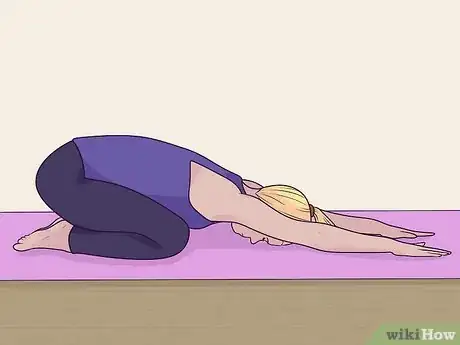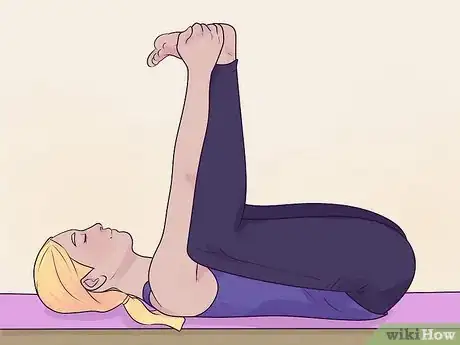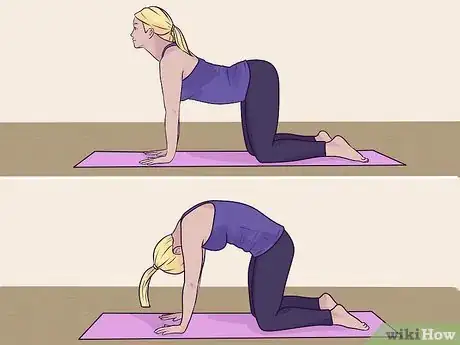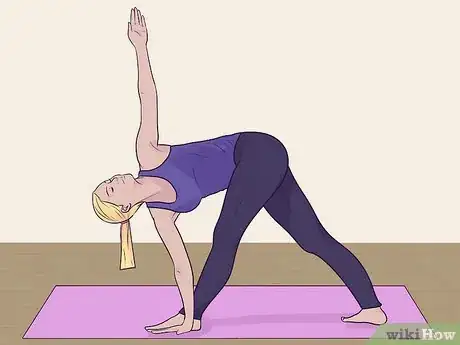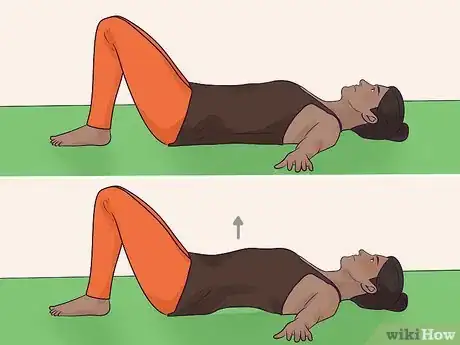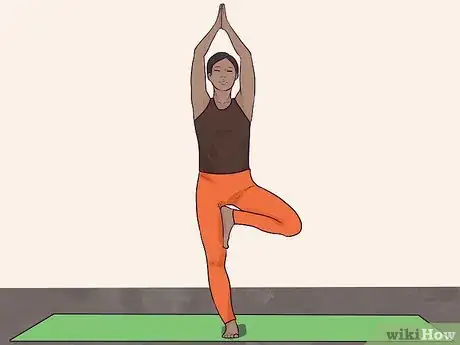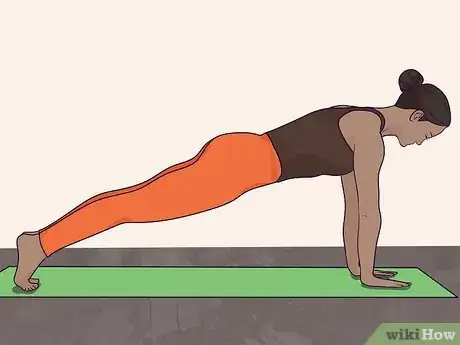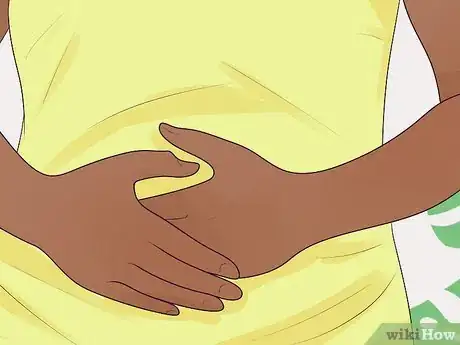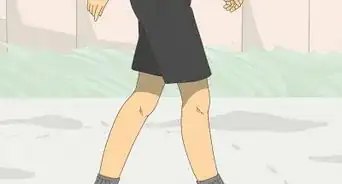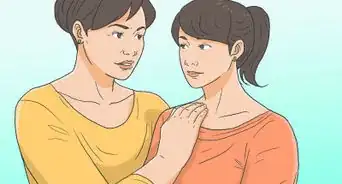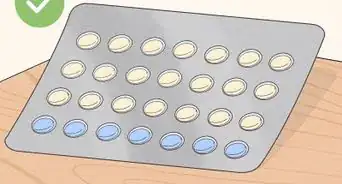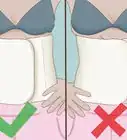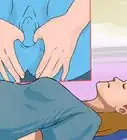This article was co-authored by Patricia Ladis PT, CBBA and by wikiHow staff writer, Eric McClure. Patricia Ladis PT, CBBA is a Licensed Physical Therapist and the Founder of WiseBody Physical Therapy out of New York, NY. With over 22 years of experience, Patricia specializes in providing a collaborative and holistic approach to pain, including nerve and chronic pain, injury prevention, and prenatal/postpartum wellness. She holds a BS in Physical Therapy from New York University. Patricia is a Certified Behavioral Breathing Analyst (CBBA) and holds certifications in Kinetic Control’s Performance Matrix Assessment Screen and the Integrative Systems Model. She co-founded First 1000 Days of Wellness, an educational platform for practitioners and the public to improve perinatal wellness. Patricia has been featured in Forbes, Vogue, and Men’s Health and has made television appearances on NBC and CBS.
There are 15 references cited in this article, which can be found at the bottom of the page.
This article has been viewed 9,269 times.
It can be hard to fit in enough time for exercise in the exciting and busy time after your childbirth. Getting physically active as soon as you can is really beneficial, but your body has been through a lot and you probably don’t have time to hit the gym. This is why postpartum yoga is so great! It’s not super difficult on your body, and you can fit a workout in from the comfort of your own home. Before you start, make sure you get the green light from your doctor just to be safe, and wait at least 6-8 weeks before doing yoga if you’ve had a c-section.
Steps
Beginner Poses
-
1Begin with focused breathing to relax and center yourself. Lay your yoga mat out and sit comfortably on it with a straight back. Set your thumb and ring finger over the bridge of your nose and gently close your right nostril. Inhale, and at the top of your inhalation take a brief moment to feel the air in your body. Exhale slowly and switch nostrils. Do this 5 more times to center yourself and prepare for some yoga![1]
- This is known as Nadi shodhana, or alternate nostril breathing. This a more calming form of deep breathing, which is especially beneficial after giving birth.[2]
- Focused breathing is especially beneficial if you’re feeling a little stressed and you want to put yourself in a more peaceful state of mind.
- You can do this breathing exercise at any time to soothe any nerves or anxiety you’re experiencing.
-
2Work your hips and abs by going into the child’s pose. Get on all fours or stay where you are if you’re the cat-and-cow. Extend your hands forward a bit and gently lean your hips back. Keep your knees on the floor and rest the back of your thighs against your hamstrings so that you feel it in your back, hips, and core. Hold this pose anywhere from 30 seconds to a few minutes based on your preference, and relax.[3]
- If you want some extra support, slide a pillow under your head and upper body.
- This position promotes blood flow in your abdomen, which is great if you’re feeling a little stiff.
- This pose is also a great way to open up your pelvic floor.[4]
Advertisement -
3Perform the corpse pose to relax and center yourself. Slowly get on to your back and spread your arms and legs out slightly so that your limbs are resting flat against the ground. Take a big, deep breath and feel your body relax on the ground. Take another breath and just let go of any tension you’re experiencing. If your mind wanders, bring it back to your breathing. Do this for anywhere from 1-5 minutes based on your preference.[5]
- This is a good pose to return to whenever you’re done with your yoga session.
-
4Reduce ankle swelling with the legs-up-the-wall pose. If your legs or ankles feel inflamed, slide your mat over to a wall and place a pillow on the ground. Lie down with your lower back on the pillow and lift your feet up on to the wall. Place your hands out at your side and straighten your legs. Keep your knees together and hold this position for 5-10 minutes.[6]
- This pose may help to strengthen your core. A lot of people find that their stomach feels better after doing this one as well.[7]
- This one can be a little tough if you’ve never done it before. Just go slow and take your time. If you can’t get into a 90-degree angle with your legs on the wall, feel free to slide away from the wall a bit.
-
5Relax your pelvic muscles with the happy baby pose. Lie on your back and slowly raise your knees up to your chest. Hold the inside of your knees and angle your legs out so they’re slightly wider than your hips. Bend your knees so your feet face upward and move your hands to your feet. Pull them down and focus on your breathing for 90 seconds before relaxing.[8]
- Your pelvic muscles often tighten up after giving birth. This is great pose to sooth any pelvic pain and relieve that tension.
- If you can’t grip your feet in this position, that’s fine! Just hold your knees.
-
6Activate your core and back with the cat-and-cow. Get on all fours and position your hands directly underneath your shoulders. Take a deep breath, pull your belly button up to your spine, and put an arch in your back.[9] Hold this for a few moments, and lower your belly while raising your head up. Curve your body in the opposite direction and hold this position with the grove in your back. Do this 5-10 times.[10]
- Skip this one if you have abdominal separation (diastasis recti) as a result of your labor. This particular exercise can cause your abdominal muscles to separate even further.[11]
- You can do this by lying on your side and bending your knees if you want some extra support. This may be easier for you depending on how sore you are or if you’re getting back to physical activity 6-8 weeks after a c-section.[12]
-
7Get your entire body’s blood flowing with the triangle pose. Stand up and spread your feet apart so that they’re wider than your shoulders. Turn your right foot to the right, inhale, and bend from your left hip to the right. Place your right hand on the ground and raise your left arm straight up so that your back is parallel to the ground. Hold this for 1-2 minutes and then stand back up straight. Repeat this pose by reversing directions and placing your left hand on the ground.[13]
- This is a great whole-body pose that will help ease neck and back pain. It’s definitely on the harder-side of the beginner moves though, so feel free to skip this one if you aren’t quite there yet.
Tougher Moves
-
1Get a full-body workout with the warrior 2 pose. Stand up and spread your legs out past your shoulders so that you feel a slight tension inside of your thigh muscles. Turn your right foot out, hold your arms out straight at your sides, and bend your left knee over your left ankle. Hold this pose for 5 breaths or so and reverse directions.[14]
- This is a great way to build your endurance back up while recovering from your labor. This will engage your arms, legs, and shoulders, and help you increase your physical stamina.
-
2Break a sweat and strengthen your abs with pelvic rocks. Lie on your back with your knees bent and your feet flat on the mat. Push your belly button down towards your spine so there’s an arch in your back. Lift your hips up off of the ground, place your arms out flat on the ground to brace yourself, and rock your hips back and forth gently. Do this 20 times.[15]
- This is a great way to strengthen your core and hips, which can be especially beneficial after giving birth.
-
3Go into a tree pose to improve lower body strength, and balance. Get into a standing position and raise your right foot up against the inside of your left thigh. Bring your hands together in front of you like you’re praying and hold your elbows out at an angle. Focus on keeping your hips stable and raise your arms up above you as you breathe. Hold this for 15-30 seconds and lower your hands back to your chest before switching legs.[16]
- If you lose your balance, don’t worry about it. Just reset, take a breath, and try again.
-
4Strengthen your upper body and core with the plank pose. Get down on all fours and place your hands directly under your shoulders. Make a fist and hold your knuckles against the floor like you’re punching the ground. Raise your knees off of the floor so that your back and legs are aligned. Hold this plank position for 30-90 seconds.[17]
- You probably aren’t ready to go back to pumping iron at the gym, but this is a good alternative. The plank pose will work your abs, arms, shoulders, and back to help you start building some muscle.
- Side planks are another great way to work your core.[18]
-
5Soothe neck and shoulder pain with the cow face pose. Sit with your legs stretched out in front of you and bend your left leg. Slide your left foot underneath your right hip and bend your right knee over your left leg so your knees are touching. Stick your arms behind you with the right hand under your neck and your left hand over your neck (hold your hands if you can). Stick your chest out and breath for 30-60 seconds. Then, reverse the instructions so your right hand is on top and repeat.[19]
- This is a great pose if you want to calm down a bit and stabilize after a long yoga session.
Safety Precautions
-
1Wait 6-8 weeks and check in with your doctor if you had a c-section. You’ve likely already had this chat with your doctor or midwife, but if you had a c-section, you may have some unique aftercare instructions that require bedrest. Typically, you need to wait 6-8 weeks to heal before you do anything physically arduous. Talk to your doctor before you start doing yoga just to make sure that it’s safe.[20]
- If you didn’t have a c-section and your delivery had no complications, you may be able to start doing postpartum yoga after a few days whenever you feel ready. You should still check in with your doctor first, though.[21]
-
2Stay away from poses that require deep twisting or the splits. These are especially dangerous if you had a c-section or you have diastasis recti. Even if you didn’t though, twists and splits are likely going to be very stressful for your pelvic floor. These poses tend to put way too much pressure on your muscles, and you may do more harm than good, so just stay away from these for now.[22]
- You can get back to these tougher poses after you feel like you’ve totally healed from childbirth. For some women, this will be a month, for others it will be 6 months. Just take it slow and be careful.
- Inverted poses, like shoulder stands, may also be especially hard on your abdominal muscles.
-
3Take a break and talk to your doctor if you feel any odd sensations. While being physically active after childbirth is good for you, your body does need some time to heal. If you start doing postpartum yoga and you experience any strange sensations, extreme pain, or serious emotional shifts, check in with your doctor. You’re probably fine, but it’s always better to be a little on the safe side so that you can be happy and healthy while you care for your child.[23]
-
4Take it slow and be patient with your body. Having a baby is hard, and it’s okay to spend a few weeks relaxing, enjoying your time, and bonding with your child. You’re probably going to be super busy as well, and you may not have a ton of energy leftover to work out every day. All of this is totally normal and fine; take things slowly, enjoy yourself, and don’t get down about skipping any workouts.[24]
- Your body has been through a lot. Don’t push yourself too hard or too fast. Exercise should be fun and relaxing, not painful or upsetting.
How Often Should You Practice Yoga?
Expert Q&A
-
QuestionWhat yoga poses help to strengthen your core?
 Patricia Ladis PT, CBBAPatricia Ladis PT, CBBA is a Licensed Physical Therapist and the Founder of WiseBody Physical Therapy out of New York, NY. With over 22 years of experience, Patricia specializes in providing a collaborative and holistic approach to pain, including nerve and chronic pain, injury prevention, and prenatal/postpartum wellness. She holds a BS in Physical Therapy from New York University. Patricia is a Certified Behavioral Breathing Analyst (CBBA) and holds certifications in Kinetic Control’s Performance Matrix Assessment Screen and the Integrative Systems Model. She co-founded First 1000 Days of Wellness, an educational platform for practitioners and the public to improve perinatal wellness. Patricia has been featured in Forbes, Vogue, and Men’s Health and has made television appearances on NBC and CBS.
Patricia Ladis PT, CBBAPatricia Ladis PT, CBBA is a Licensed Physical Therapist and the Founder of WiseBody Physical Therapy out of New York, NY. With over 22 years of experience, Patricia specializes in providing a collaborative and holistic approach to pain, including nerve and chronic pain, injury prevention, and prenatal/postpartum wellness. She holds a BS in Physical Therapy from New York University. Patricia is a Certified Behavioral Breathing Analyst (CBBA) and holds certifications in Kinetic Control’s Performance Matrix Assessment Screen and the Integrative Systems Model. She co-founded First 1000 Days of Wellness, an educational platform for practitioners and the public to improve perinatal wellness. Patricia has been featured in Forbes, Vogue, and Men’s Health and has made television appearances on NBC and CBS.
Licensed Physical Therapist Standing poses can help! You're lengthening and engaging your core throughout these exercises.
Standing poses can help! You're lengthening and engaging your core throughout these exercises.
References
- ↑ https://www.yogajournal.com/yoga-101/types-of-yoga/prenatal/calming-postpartum-yoga-sequence-for-the-fourth-trimester/
- ↑ https://www.health.harvard.edu/blog/yoga-could-slow-the-harmful-effects-of-stress-and-inflammation-2017101912588
- ↑ https://www.yogajournal.com/yoga-101/types-of-yoga/prenatal/calming-postpartum-yoga-sequence-for-the-fourth-trimester/
- ↑ Patricia Ladis PT, CBBA. Licensed Physical Therapist. Expert Interview. 19 March 2021.
- ↑ https://youtu.be/40z3vMD89uw?t=1936
- ↑ https://www.yogajournal.com/yoga-101/types-of-yoga/prenatal/calming-postpartum-yoga-sequence-for-the-fourth-trimester/
- ↑ https://youtu.be/_OQEIiZLY-0?t=148
- ↑ https://www.mayoclinic.org/healthy-lifestyle/labor-and-delivery/in-depth/exercise-after-pregnancy/art-20044596
- ↑ Patricia Ladis PT, CBBA. Licensed Physical Therapist. Expert Interview. 19 March 2021.
- ↑ https://youtu.be/FuFQdJQSiuc?t=63
- ↑ https://www.mother.ly/lifestyle/yoga-moves-to-avoid-after-giving-birth
- ↑ https://www.tommys.org/pregnancy-information/giving-birth/caesarean-section/when-and-how-exercise-after-c-section
- ↑ https://youtu.be/-Qq6hp2wb2g?t=57
- ↑ https://www.yogajournal.com/lifestyle/health/womens-health/postnatal-yoga-conditions-and-cures-for-both-mama-and-babe/
- ↑ https://www.yogajournal.com/lifestyle/health/womens-health/postnatal-yoga-conditions-and-cures-for-both-mama-and-babe/
- ↑ https://youtu.be/40z3vMD89uw?t=848
- ↑ https://www.yogajournal.com/poses/types/strength/plank-pose/
- ↑ Patricia Ladis PT, CBBA. Licensed Physical Therapist. Expert Interview. 19 March 2021.
- ↑ https://www.yogajournal.com/poses/cow-face-pose/
- ↑ https://www.tommys.org/pregnancy-information/giving-birth/caesarean-section/when-and-how-exercise-after-c-section
- ↑ https://www.mayoclinic.org/healthy-lifestyle/labor-and-delivery/in-depth/exercise-after-pregnancy/art-20044596
- ↑ https://www.mother.ly/lifestyle/yoga-moves-to-avoid-after-giving-birth
- ↑ https://www.mayoclinic.org/healthy-lifestyle/labor-and-delivery/in-depth/exercise-after-pregnancy/art-20044596
- ↑ https://www.parents.com/pregnancy/my-body/postpartum/postpartum-exercise/
- ↑ https://www.mayoclinic.org/healthy-lifestyle/labor-and-delivery/in-depth/exercise-after-pregnancy/art-20044596
- ↑ https://www.mayoclinic.org/healthy-lifestyle/labor-and-delivery/in-depth/exercise-after-pregnancy/art-20044596
- ↑ https://www.mayoclinic.org/healthy-lifestyle/labor-and-delivery/in-depth/exercise-after-pregnancy/art-20044596

